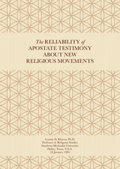In the last thirty years, apostasy has once again become an issue in public as well as private circles, although as noted above, the treatment of the present-day apostate bears little resemblance to the way apostates were regarded in the past. Since the 1960s, a variety of new religious movements have appeared in all modern, democratic societies. Many of these minority religious movements make “totalizing” demands of their members, claiming absolute commitment to their religious teachings and complete devotion to their religious community. Other new religions do not require complete immersion of all members in their communal life and mission, yet still require strict adherence to doctrinal, ethical, and ritual standards. Certainly all new religions hold beliefs and practices that are at variance with mainstream religions. Not surprisingly, given these rigorous demands, some of those who became involved soon decide that a particular religious movement is not for them and leave. Their departure usually goes unnoticed because most of the individuals involved regard their past experience positively as one more step in their own spiritual journey.
But in contrast to the above, among those who leave voluntarily are a few defectors who have gained great notoriety by publicly attacking their former religious associations and activities through the press and in the courts. As welcome sources of information for a public both curious and fearful about these unfamiliar new religions, such apostates are often treated as cause celebres rather than as social outcasts. But, as we shall see below, neither the quietly appreciative former member nor the vocally aggrieved apostate from a new religious movement can be taken as an objective and authoritative interpreter of the religious movement to which he or she formerly belonged.
IV.I. Types of Departure
There is a widespread misconception in the general public that few departures from new religious movements are voluntary and positive experiences. The image of new religions as highly regimented groups that control the thoughts and actions of their members through a variety of “mind control” techniques is deeply embedded in the public imagination, thanks to the media fixation on the horror stories of former members and to the propaganda of anti-cult groups. Even many early scholarly descriptions of new religious movements perpetuated this mistaken notion by basing their studies almost entirely on apostates who were forcibly separated from their previous religious associations either by coercive deprogramming or involuntary hospitalization. But a number of recent scholarly studies (e.g., James A. Beckford, Cult Controversies: The Societal Response to New Religious Movements, London: Tavistock Publications, 1985; Stuart A. Wright, Leaving Cults: The Dynamics of Defection, Washington, D.C.: Society for the Scientific Study of Religion, 1987) have clearly demonstrated that two very different types of apostasy exist which, in turn, can be correlated to two very different apostate assessments of new religious movements.
Only a small minority of defections from new religious movements are the result of coerced apostasy. Forcible efforts to “rescue” a given individual from a new religious movement are always initiated by outsiders. Relatives who are opposed to an individual’s involvement in a new religion are faced with a double problem—why that person joined and how that person can be separated from that religion.
The first question is typically answered by a “brainwashing” explanation which, in turn, justifies a “deprogramming” solution to the second problem. The brainwashing scenario “explains” how a convert to a new religion comes to embrace and defend what to the outsider seems to be such absurd beliefs and practices. The individual in question is seen as the victim of various psychological and sociological techniques of mind control. Given that circumstance, the only means of rescuing that person is some dramatic form of intervention that will free the individual from such bondage. Recourse to forcible kidnapping and deprogramming or to legal conservatorship and hospitalization are justified as the necessary means for saving from themselves misguided and manipulated followers of the new religions. In one form or another, allegations of brainwashing and justifications of deprogramming are the bases of all such “rescue operations.”
Contrary to public opinion, the overwhelming majority of defections from new religious movements are a matter of voluntary apostasy. Moreover, the clear majority of those who leave of their own free will speak positively of certain aspects of their past experience.
Because of their high visibility in media exposés and legal proceedings against their former religious associates, such coerced apostates have helped to foster the controversy surrounding new religious movements. Their availability as “cult survivors” makes them hot copy for the media, which is often the only information about new religious movements that is available to the general public. At this stage of the process, the logical connection between brainwashing and deprogramming works in reverse. The very fact that the deprogramming process “works” is taken as evidence by concerned outsiders as well as some former members that the brainwashing scenario is true. The abrupt and radical change in their belief and behavior brought about by deprogramming is seen as clear proof that the retrieved individual was, in fact, the victim if not the prisoner of a malevolent religion. Moreover, the fact that they “got their loved one back” prompts relatives to help others “get their children back” by going public with their story and by supporting the anti-cult organizations that supported them. In this way, a small percentage of apostates and their “rescuers” have shaped (or, more properly, misshaped) the public’s perception of all defectors from new religious movements.
Contrary to public opinion, the overwhelming majority of defections from new religious movements are a matter of voluntary apostasy. Moreover, the clear majority of those who leave of their own free will speak positively of certain aspects of their past experience. While readily acknowledging the ways a given religious movement failed to meet their personal expectations and spiritual needs, many voluntary defectors have found ways of salvaging some redeeming values from their previous religious associations and activities.
But there are some voluntary apostates from new religious movements who leave deeply embittered and harshly critical of their former religious associations and activities. Their dynamics of separation from a once-loved religious group is analogous to an embittered marital separation and divorce. Both marriage and religion require a significant degree of commitment. The greater the involvement, the more traumatic the break-up. The longer the commitment, the more urgent the need to blame the other for the failed relationship. Long-term and heavily involved members of new religious movements who over time become disenchanted with their religion often throw all of the blame on their former religious associations and activities. They magnify small flaws into huge evils. They turn personal disappointments into malicious betrayals. They even will tell incredible falsehoods to harm their former religion. Not surprisingly, these apostates often appeal, after the fact, to the same brainwashing scenarios usually invoked to justify forcible disengagement from new religious movements.
IV.II. Tactics of Re‐entry
Disengagement from former religious associations and activities is only half the process of renouncing one’s faith in a new religious movement. The apostate, whether voluntary or coerced, faces the more formidable tasks of returning to the dominant culture and of reformulating a new identity and worldview. Re-entry seldom means simply returning to one’s previous lifestyle and worldview before joining a new religious movement. The “prodigal” son or daughter returns as a different person, bringing a whole set of experiences that must somehow be explained and integrated into a new psychological and social situation. This transition is often influenced by family systems, social networks, religious groups, educational institutions, and anti-cult organizations. Not surprisingly, the influence of these groups profoundly colors the apostate’s interpretation of past religious activities and associations.
Regardless of the manner of their leave-taking, apostates must take account of both their earlier conversion to and subsequent separation from a non-traditional religious movement. They often receive the self‐justification they are seeking from anti-cult organizations or fundamentalist religious groups, both of whom provide them with the brainwashing explanations to rationalize their sudden adherence and equally sudden abandonment of a new religious movement. The information provided by these groups is usually highly negative and heavily biased against the organization left behind. More precisely, these groups furnish them a lingua franca for telling their stories of seduction and liberation. Numerous social scientists have pointed out that these biographies of “cult survival” are highly stylized accounts that betray the influence of borrowed scenarios of captivity and liberation — each account a rehearsed story of social isolation, emotional manipulation, physical deprivation, economic exploitation, and hypnotic control. These “atrocity tales” serve both to excuse the individual apostate as well as to accuse the new religion of irrational belief and immoral behavior. They also feed and form public perceptions of the new religions as dangerous threats to religious freedom and civil order. Given this negative press, even those apostates who do not fall under the direct influence of anti-cult organizations or fundamentalist religious groups are often influenced by their negative portrayals of the religion they have left behind.





























